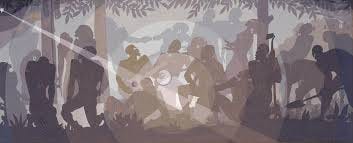
Aaron Douglas was a seminal figure of the Harlem Renaissance whose innovative paintings and murals forged a new visual language that integrated African heritage with modernist aesthetics. His work not only defined an era in American art but also provided a powerful visual commentary on race, identity, and the African American experience.
Born on May 26, 1899, in Topeka, Kansas, Aaron Douglas emerged from humble beginnings into a world where opportunity for African American artists was extremely limited. Douglas earned a Bachelor of Fine Arts from the University of Nebraska in 1922, a significant achievement at a time when educational opportunities for Black artists were scarce. Following graduation, he taught art at Lincoln High School in Kansas City, Missouri. In 1925, drawn by the cultural explosion of the Harlem Renaissance, Douglas relocated to New York City. Harlem provided a fertile ground for artistic exploration and political activism, and Douglas quickly became immersed in its vibrant artistic community (Kirschke 28). His formal training was supplemented by the rich oral and visual traditions of African art, which would later emerge as a defining element in his work.
Douglas’s work is characterized by a distinctive synthesis of African motifs, modernist abstraction, and elements of European Cubism. His style is marked by bold geometric forms, layered compositions, and a limited, yet striking, color palette that often evokes the chiaroscuro of earlier European art traditions. Influenced by African art, Douglas reinterpreted traditional visual symbols (such as masks, silhouettes, and ritualistic patterns) and reimagined them within a modern context. He was also inspired by the social and political currents of his time; the turbulent atmosphere of the Harlem Renaissance, with its focus on racial pride and cultural reclamation, fueled his desire to create images that resonated with the struggles and aspirations of African Americans (Earle, editor 53).
Douglas’s approach was both innovative and accessible. He believed that art should not only reflect beauty but also serve as a vehicle for social change. His use of layered imagery and symbolic forms was a deliberate effort to evoke a sense of historical continuity, linking the past of African civilizations with the contemporary experience of Black Americans. This blending of the old and new helped to establish his reputation as a “modernist” who was deeply rooted in African aesthetics (Powell 110).




One of Douglas’s most celebrated projects is his mural series Aspects of Negro Life, commissioned by the Works Progress Administration (WPA) in 1934 for the Harlem branch of the New York Public Library. The series, composed of panels titled “The Negro in an African Setting,” “An Idyll of the Deep South,” “From Slavery Through Reconstruction,” and “Song of the Towers,” chronicles the African American journey from ancestral Africa through the horrors of slavery and the hope of renewal during Reconstruction and the Great Migration. These murals are noted for their narrative strength and their powerful symbolic imagery, which articulate both suffering and triumph (Smithsonian American Art Museum).
Other notable works include the painting Building No. 1 (1933) and Song of the Towers (1934), which further exemplify his signature style. Through these works, Douglas communicated themes of community, resilience, and cultural identity. His art often functioned as a form of visual storytelling that bridged historical experience with modern aspirations. In his representations, the figures are rendered with a dignified simplicity that speaks to the quiet strength of the African American spirit, while the geometric patterns suggest the enduring structures of African cultural heritage (Kirschke 74).
Aaron Douglas’s influence extends far beyond the period of the Harlem Renaissance. His work helped to establish a vocabulary for African American modernism that has continued to inform the work of later generations. Douglas is often referred to as the “father of African American art” due to his pioneering role in integrating African aesthetics with modern art forms. His murals and paintings are housed in prominent institutions such as the Smithsonian American Art Museum, the Metropolitan Museum of Art, and the Studio Museum in Harlem, ensuring that his legacy endures in both academic study and public appreciation (Earle, editor 97).
Scholars have noted that Douglas’s work not only provided a visual counter-narrative to the dominant Eurocentric art traditions of his time but also offered a means for African Americans to reclaim their cultural history. His innovative approach to composition and symbolism influenced contemporaries and later artists alike, contributing to a broader understanding of modernism that is inclusive of diverse cultural perspectives (Powell 117; McKenna and Horowitz 45).
Aaron Douglas’s groundbreaking career transformed the visual language of the Harlem Renaissance and left an indelible mark on American art. By fusing African aesthetics with modernist techniques, he created a powerful narrative of struggle, resilience, and hope that continues to resonate. His work remains a vital reference point for discussions about race, art, and cultural identity. As both an innovator and a storyteller, Douglas not only captured the spirit of his time but also paved the way for future generations of artists to explore and express the complexities of the African American experience.
References:
Earle, Susan, editor. Aaron Douglas: African American Modernist. Yale University Press, 2007.
Kirschke, Amy Helene. Aaron Douglas: Art, Race, and the Harlem Renaissance. University Press of Mississippi, 1995.
McKenna, Jim, and Carol Horowitz. African American Visual Artists, 1880-1980: A Biographical Dictionary. Greenwood Press, 1989.
Powell, Richard J. Paint That Thing! Aaron Douglas's Call to Modernism. American Studies, vol. 49, no. 1/2, 2008, pp. 107–119.
Edmonia Lewis. Smithsonian American Art Museum, https://americanart.si.edu/artist/edmonia-lewis-2914. Accessed 2 Jan. 2025.
Harlem Renaissance and the Art of Aaron Douglas. Metropolitan Museum of Art, https://www.metmuseum.org/toah/hd/harr/hd_harr.htm. Accessed 2 Jan. 2025.




You’re hitting all the notes 🎵🎼🎶🥁👏🏾🎷😂✨with this one. Funny we were just chatting about NYC and this really brings up all the qualities of a period in art when everyone was in the swing.